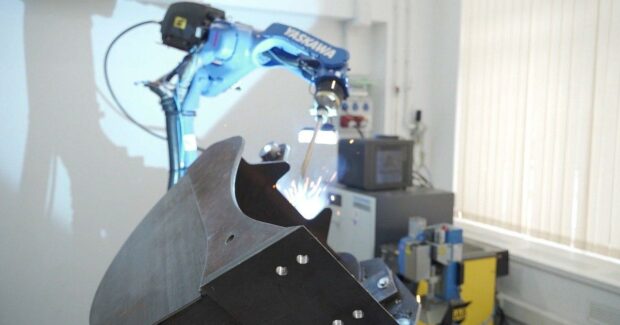The Robotization of High-mix, Low-volume Production Gains Momentum
How AI and machine vision expand the possibilities of robotics and make robots effective even for custom projects and one-of-a-kind parts.
Posted: June 14, 2023
ADVANCING AUTOMATION

Why were robots not applicable for high-mix production in the past?
Here is one example of how acute the labor shortage is. According to the American Welding Society, the United States is projected to face a shortage of 400,000 welders by 2024. Right now, 80% of welders are over 35 years old, and young people do not want to take on this dangerous and hard work. The same goes for other workers.
At the same time, the process of robotization is going very slowly. The International Federation of Robotics estimates robot density in the United States was 274 units per 10,000 employees in 2021, or 2.74%.
Why are robots so needed, and yet there are so few of them? The answer lies in technological limitations. Until now, the belief has been that robotization is only applicable to the mass production of thousands of identical products. Two examples are the automotive industry and electronics. There was a stereotype that robots could not be effective for high-mix, low-volume production – the most prevalent type of production – because the range of products manufactured is wide and constantly changing.
There are two reasons for this:
1. Every move of a robot must be programmed, and the programming is long and costly. It can take from several hours to several weeks or even months.
2. Real production differs from perfect blueprints. Robots, however, operate with almost zero tolerance for any deviations in a workpiece or its position, which results in their inability to work around irregularities.
So, how are new technologies addressing the situation? The recent development of computer vision algorithms, technical vision devices, and overall computational power provides an opportunity to make industrial robots autonomous, flexible, and adaptive to different tasks.

One company, ABAGY, overcomes the limitations of traditional robotics. With this software, manufacturers can use robots for custom projects or even one-of-a-kind parts. No robot programming is required. The software automatically generates a robot program to produce a specific product, which only takes minutes. Using machine vision, the system scans the parts and adjusts the robot’s path depending on the actual position and deviations of the product.
Key robot manufacturers confirm the high-mix, low-volume production robotization trend. Darcy Charbonneau, sales director USA at KUKA says that more high-mix, low-volume customers come to them looking for solutions. Jon Karr, vice president at FANUC America agrees with this, noting that FANUC has traditionally worked with the automotive industry, but now sees great interest from general industry customers with high-mix manufacturing, for which new technologies are needed.
Let’s look at the numbers again. A3 Association for Advancing Automation‘s latest quarterly stats shows 35,804 robots ordered in the United States between January and September 2022, an increase over the same period in 2021. Non-automotive orders represent 58% of the North American total. In particular, robot unit sales to metals industries increased to 91% in 2021 over 2020.
Let’s analyze an example. A manufacturer in Sabetha, Kan., already had a robotic cell, but wanted to increase its utilization. The robotic cell was used for a limited number of parts because the programming was tedious. After implementing a new system with AI and machine vision, the setup time reduced dramatically — only 10-to-15 minutes for a new product — and the robot can now be used for many more products. It used to take 90-to-120 minutes to program a robot to produce one rotor. That’s a big win for a manufacturer with high-mix production. In the first month of the robotic cell’s operation, the company created 50 different technical charts. The company plans further robotization of production.
What are some products that can be welded with autonomous robots? Let’s look at examples to break down the tech.
Excavator buckets
Typically, excavator buckets are welded manually. With the traditional approach, robotic welding for this product is a challenging task for two reasons:
1. Almost every excavator bucket is unique, meaning each one will require new programming.
2. Teach-pendant programming for this product will take a lot of time due to many different weld types, as well as the need to synchronize the robot and the positioner. After bending the metal, many deviations occur.
Augers
Augers pose a real challenge for welders, both human and robot. Having to stop and restart welding while rotating the auger can lead to bad welds. The smart system coordinates the simultaneous movements of the auger and the torch to create a uniform, continuous bead.
Another question manufacturers have is how compatible new technologies are with different equipment. These solutions are compatible with various robot brands such as FANUC, KUKA, Panasonic, Kawasaki, and Yaskawa, as well as welding power source brands such as Fronius, Lincoln, ESAB, and Miller.
Robotic cells’ configurations also can vary, such as one/multiple robots; one/multiple work areas; with/without external axis (tracks, gantry systems, positioners, rotators, etc.).
This is an important point for manufacturing. Two factors converged: on the one hand, an acute labor shortage increases the demand for robots; on the other hand, AI and machine vision technologies expand the applicability of robots – including high-mix production – and respond to this increased demand. Those manufacturers who use new opportunities sooner will be able to solve the problem with a workforce, but also outperform competitors in the market.
Subscribe to learn the latest in manufacturing.


















